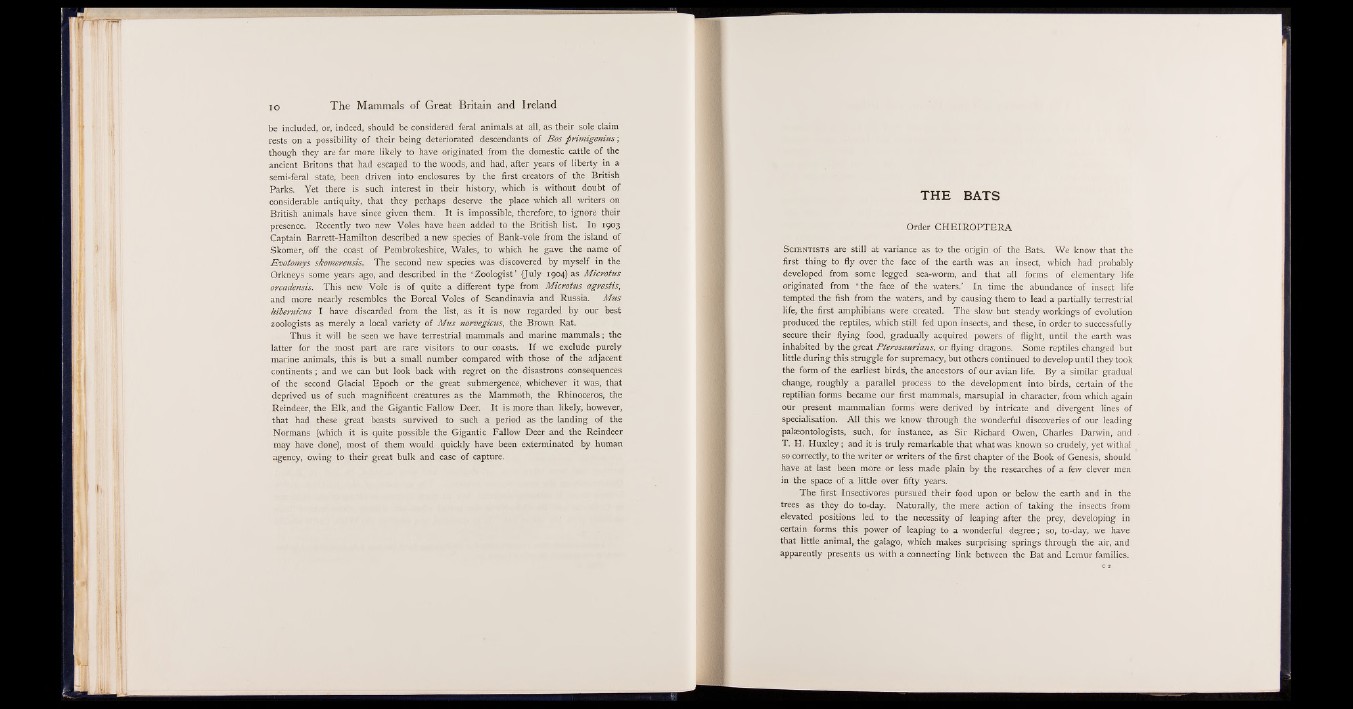
be included, or, indeed, should be considered feral animals at all, as their sole claim
rests on a possibility of their being deteriorated descendants of Bos primigenius\
though they are far more likely to have originated from the domestic cattle of the
ancient Britons that had escaped to the woods, and had, after years of liberty in a
semi-feral state, been driven into enclosures by the first creators of the British
Parks. Yet there is such interest in their history, which is without doubt of
considerable antiquity, that they perhaps deserve the place which all writers on
British animals have since given them. It is impossible, therefore, to ignore their
presence. Recently two new Voles have been added to the British list. In 1903
Captain Barrett-Hamilton described, a new species of Bank-vole from the island of
Skomer, off the coast of Pembrokeshire, Wales, to which he gave the name of
Evotomys skomerensis. The second new species was discovered by myself in the
Orkneys some years ago, and described in the ‘ Zoologist’ (July 1904) as Microtus
orcadensis. This new Vole is of quite a different type from Microtus agrestis,
and more nearly resembles the Boreal Voles of Scandinavia and Russia. Mus
hibemicus I have discarded from the list, as it is now regarded by our best
zoologists as merely a local variety of Mus norvegicus, the Brown Rat.
Thus it will be seen we have terrestrial mammals and marine mammals; the
latter for the most part are rare visitors to our coasts. I f we exclude purely
marine animals, this is but a small number compared with those of the adjacent
continents; and we can but look back with regret on the disastrous consequences
of the second Glacial Epoch or the great submergence, whichever it was, that
deprived us of such magnificent creatures as the Mammoth, the Rhinoceros, the
Reindeer, the Elk, and the Gigantic Fallow Deer. It is more than likely, however,
that had these great beasts survived to such a period as the landing of the
Normans (which it is quite possible the Gigantic Fallow Deer and the Reindeer
may have done), most of them would quickly have been exterminated by human
agency, owing to their great bulk and ease of capture.
THE BATS
Order CHEIROPTERA
S c i e n t i s t s are still at variance as to the origin of the Bats. We know that the
first thing to fly over the face of the earth was an insect, which had probably
developed from some legged sea-worm, and that all forms of elementary life
originated from ‘ the face of the waters.’ In time the abundance of insect life
tempted the fish from the waters, and by causing them to lead a partially terrestrial
life, the first amphibians were created. The slow but steady workings of evolution
produced the reptiles, which still fed upon insects, and these, in order to successfully
secure their flying food, gradually acquired powers of flight, until the earth was
inhabited by the great Pterosaurians, or flying dragons. Some reptiles changed but
little during this struggle for supremacy, but others continued to develop until they took
the form of the earliest birds, the ancestors of our avian life. By a similar gradual
change, roughly a parallel process to the development into birds, certain of the
reptilian forms became our first mammals, marsupial in character, from which again
our present mammalian forms were derived by intricate and divergent lines of
specialisation. All this we know through the wonderful discoveries of our leading
palaeontologists, such, for instance, as Sir Richard Owen, Charles Darwin, and
T. H. Huxley; and it is truly remarkable that what was known so crudely, yet withal
so correctly, to the writer or writers of the first chapter of the Book of Genesis, should
have at last been more or less made plain by the researches of a few clever men
in the space of a little over fifty years.
The first Insectivores pursued their food upon or below the earth and in the
trees as they do to-day. Naturally, the mere action of taking the insects from
elevated positfons led to the necessity of leaping after the prey, developing in
certain forms this power of leaping to a wonderful degree; so, to-day, we have
that little animal, the galago, which makes surprising springs through the air, and
apparently presents us with a connecting link between the Bat and Lemur families.